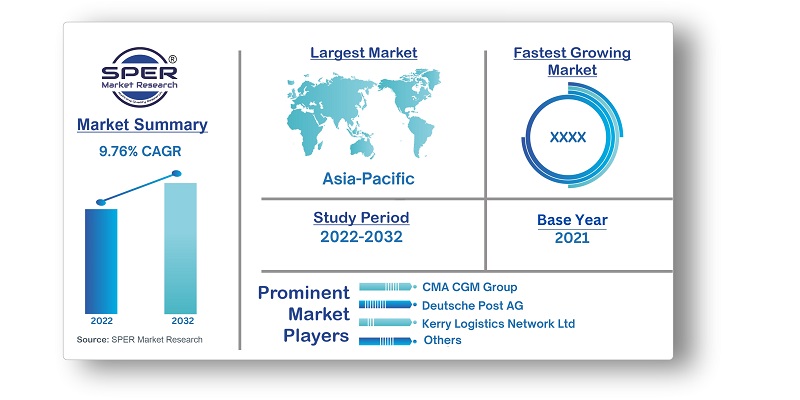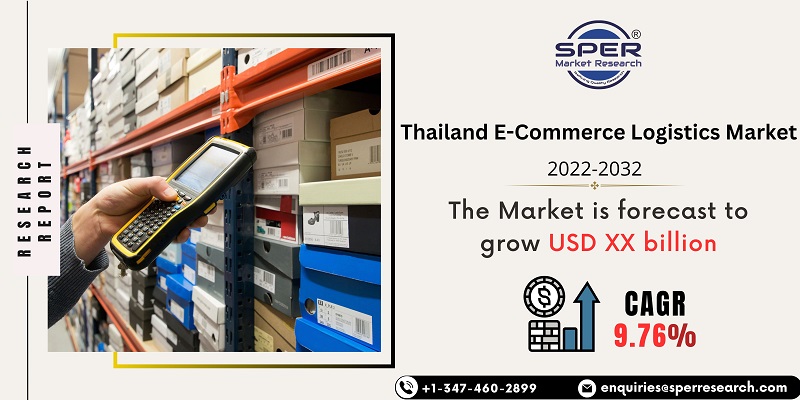
Thailand E-Commerce Logistics Market Growth, Trends, Size, Share, Revenue and Future Strategies
Thailand E-Commerce Logistics Market Size-By Delivery, By Mode of Payment, By Shipment Weight, By E-Commerce Value, By Booking Mode, By Product Category- Regional Outlook, Competitive Strategies and Segment Forecast to 2032
| Published: Mar-2023 | Report ID: AMIN2354 | Pages: 1 - 105 | Formats*: |
| Category : Automotive & Transportation | |||
- Increasing E-commerce Adoption: Due to changing consumer demands and convenience, firms in Thailand have increased their use of e-commerce platforms. More companies are developing an online presence and selling their products through e-commerce channels. Because of the increase in e-commerce activity, there is a greater need for efficient and dependable logistics solutions to handle order fulfillment and last-mile delivery.
- Increasing Internet and Smartphone Penetration: Thailand has seen a tremendous increase in internet and smartphone penetration rates, allowing a bigger section of the population to use e-commerce platforms. The growing number of online customers has increased demand for e-commerce logistics services to facilitate the delivery of items ordered online.


| Report Metric | Details |
| Market size available for years | 2019-2032 |
| Base year considered | 2022 |
| Forecast period | 2022-2032 |
| Segments covered | By Delivery, By Mode of Payment, By Shipment Weight, By E-Commerce Value, By Booking Mode, By Product Category |
| Regions covered | Bangkok, Central Region, Northern Region, Northeastern Region, Southern Region |
| Companies Covered | CMA CGM Group, Deutsche Post AG, Kerry Logistics Network Ltd., MON Logistics Group Co. Ltd., SCG Logistics Management Co. Ltd., Schenker AG, Unithai Group, WICE Logistics Public Company Ltd., Yamato Unyu, YUSEN LOGISTICS CO. LTD. |
- E-commerce Businesses
- Online Marketplaces
- Retailers and Brands
- Logistics Service Providers
| By Delivery: |
|
| By Mode of Payment: |
|
| By Shipment Weight: |
|
| By E-Commerce Value: |
|
| By Product Category: |
|
- Thailand E-Commerce Logistics Market Size (FY’2022-FY’2032)
- Overview of Thailand E-Commerce Logistics Market
- Segmentation of Thailand E-Commerce Logistics Market By Delivery (Same Day, Next Day, Two days)
- Segmentation of Thailand E-Commerce Logistics Market By Mode of Payment (Cash, Online)
- Segmentation of Thailand E-Commerce Logistics Market By Shipment Weight (0 -1 Kg, 1 – 3 Kg, 3 – 6 Kg, Greater than 6 Kg)
- Segmentation of Thailand E-Commerce Logistics Market By E-Commerce Value (B2G, B2B, B2C)
- Segmentation of Thailand E-Commerce Logistics Market By Booking Mode (Online, Offline)
- Segmentation of Thailand E-Commerce Logistics Market By Product Category (Mobile & Electronics, Fashion, Beauty, Lifestyle & Hobby Health & Wellness, Home & Living, Toys, Mom & Baby Automotives, Sports, Others)
- Statistical Snap of Thailand E-Commerce Logistics Market
- Expansion Analysis of Thailand E-Commerce Logistics Market
- Problems and Obstacles in Thailand E-Commerce Logistics Market
- Competitive Landscape in the Thailand E-Commerce Logistics Market
- Effects of COVID-19 and demonetization on Thailand E-Commerce Logistics Market
- Details on Current Investment in Thailand E-Commerce Logistics Market
- Competitive Landscape of Thailand E-Commerce Logistics Market
- Prominent Players in the Thailand E-Commerce Logistics Market
- SWOT Analysis of Thailand E-Commerce Logistics Market
- Thailand E-Commerce Logistics Market Future Outlook and Projections (FY’2022-FY’2032)
- Recommendations from Analyst
1.1. Scope of the report1.2. Market segment analysis
2.1 Research data source2.1.1 Secondary data2.1.2 Primary data2.1.3 SPER’s internal database2.1.4 Premium insight from KOL’s2.2 Market size estimation2.2.1 Top-down and Bottom-up approach2.3 Data triangulation
4.1. Driver, Restraint, Opportunity and Challenges analysis4.1.1 Drivers4.1.2 Restraints4.1.3 Opportunities4.1.4 Challenges4.2. COVID-19 Impacts of the Thailand E-Commerce Logistics Market
5.1. SWOT analysis5.1.1 Strengths5.1.2 Weaknesses5.1.3 Opportunities5.1.4 Threats5.2. PESTEL analysis5.2.1 Political landscape5.2.2 Economic landscape5.2.3 Social landscape5.2.4 Technological landscape5.2.5 Environmental landscape5.2.6 Legal landscape5.3. PORTER’S five forces analysis5.3.1 Bargaining power of suppliers5.3.2 Bargaining power of Buyers5.3.3 Threat of Substitute5.3.4 Threat of new entrant5.3.5 Competitive rivalry5.4. Heat map analysis
6.1 Thailand E-Commerce Logistics Manufacturing Base Distribution, Sales Area, Product Type6.2 Mergers & Acquisitions, Partnerships, Product Launch, and Collaboration in Thailand E-Commerce Logistics Market
7.1. Same Day7.2. Next Day7.3. Two days
8.1. Cash8.2. Online
9.1. 0 -1 Kg9.2. 1 – 3 Kg9.3. 6 Kg9.4. Greater than 6 Kg
10.1. B2G10.2. B2B10.3. B2C
11.1. Online11.2. Offline
12.1. Mobile & Electronics12.2. Fashion12.3. Beauty12.4. Lifestyle & Hobby12.5. Health & Wellness12.6. Home & Living12.7. Toys12.8. Mom & Baby12.9. Automotives12.10. Sports12.11. Others
13.1. Thailand E-Commerce Logistics Market Size and Market Share by Region (2019-2025)13.2. Thailand E-Commerce Logistics Market Size and Market Share by Region (2026-2032)13.3. Bangkok13.4. Central Region13.5. Northern Region13.6. Northeastern Region13.7. Southern Region
14.1. CMA CGM Group14.1.1. Company details14.1.2. Financial outlook14.1.3. Product summary14.1.4. Recent developments14.2. Deutsche Post AG14.2.1. Company details14.2.2. Financial outlook14.2.3. Product summary14.2.4. Recent developments14.3. Kerry Logistics Network Ltd.14.3.1. Company details14.3.2. Financial outlook14.3.3. Product summary14.3.4. Recent developments14.4. MON Logistics Group Co. Ltd.14.4.1. Company details14.4.2. Financial outlook14.4.3. Product summary14.4.4. Recent developments14.5. SCG Logistics Management Co. Ltd.14.5.1. Company details14.5.2. Financial outlook14.5.3. Product summary14.5.4. Recent developments14.6. Schenker AG14.6.1. Company details14.6.2. Financial outlook14.6.3. Product summary14.6.4. Recent developments14.7. Unithai Group14.7.1. Company details14.7.2. Financial outlook14.7.3. Product summary14.7.4. Recent developments14.8. WICE Logistics Public Company Ltd.14.8.1. Company details14.8.2. Financial outlook14.8.3. Product summary14.8.4. Recent developments14.9. Yamato Unyu14.9.1. Company details14.9.2. Financial outlook14.9.3. Product summary
14.9.4. Recent developments
14.10. YUSEN LOGISTICS CO. LTD14.10.1. Company details14.10.2. Financial outlook14.10.3. Product summary14.10.4. Recent developments
SPER Market Research’s methodology uses great emphasis on primary research to ensure that the market intelligence insights are up to date, reliable and accurate. Primary interviews are done with players involved in each phase of a supply chain to analyze the market forecasting. The secondary research method is used to help you fully understand how the future markets and the spending patterns look likes.
The report is based on in-depth qualitative and quantitative analysis of the Product Market. The quantitative analysis involves the application of various projection and sampling techniques. The qualitative analysis involves primary interviews, surveys, and vendor briefings. The data gathered as a result of these processes are validated through experts opinion. Our research methodology entails an ideal mixture of primary and secondary initiatives.



Frequently Asked Questions About This Report
PLACE AN ORDER
Year End Discount
Sample Report
Pre-Purchase Inquiry
NEED CUSTOMIZATION?
Request CustomizationCALL OR EMAIL US
100% Secure Payment






Related Reports
Our Global Clients
Our data-driven insights have influenced the strategy of 200+ reputed companies across the globe.






















